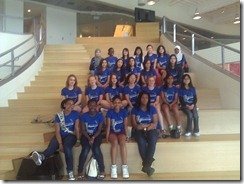Interesting Links 30 July 2012
 Over on the left here is a picture of a group of young women who visited Microsoft in Cambridge MA recently as part of Boston University’s Artemis Project. This is one of several groups of young people that we have hosted this summer. It’s great to see kids getting excited about STEM in general and computer science in particular. I’m glad that universities are running programs like this and that companies (these students had field trips to several hi-tech companies during the program) are being supportive.
Over on the left here is a picture of a group of young women who visited Microsoft in Cambridge MA recently as part of Boston University’s Artemis Project. This is one of several groups of young people that we have hosted this summer. It’s great to see kids getting excited about STEM in general and computer science in particular. I’m glad that universities are running programs like this and that companies (these students had field trips to several hi-tech companies during the program) are being supportive.
But it is interesting links day at my blog so here are some of the links I found over the last week to share with you.
How Do I (Channel 9) https://channel9.msdn.com/Blogs/How-Do-I Is a new Channel 9 series to help developers learn how to do things with Windows 8. Not unrelated are a bunch of hands on labs that I wrote about at Virtual Windows 8 Hands-on-Labs.
A pair of posts on the CSTA blog last week relate to policy and activism in support of K-12 computer science. Chris Stephenson writes about Interest in K-12 Policy Growing at the Snowbird Conference in Utah. Also Lissa Clayborn writes about : Five Advocacy Actions You Can Do in Ten Minutes or Less
Also in the news from CSTA is that downloadable versions of the speaker presentations from CS & IT 2012 are now available! SO if you missed the whole conference or just some sessions you wanted to see you can at least get the presentation slides and notes.
Looking at how to better keep you school’s labs and networks running? You may want to look at this program where students get hands-on, real-world experience in this "Lab Manager" program that seems to be working pretty darn well!
How in the world does CS Bits & Bytes newsletter have only 1100 subscribers? This bi-weekly newsletter from the National Science Foundation is a wonderful educational resource. Check it out!
Have you seen how the 23 acre AIDS Memorial Quilt goes digital with support from Microsoft Research? One very moving project that also highlights the way computers can help us with social issues as well as with “big data.”